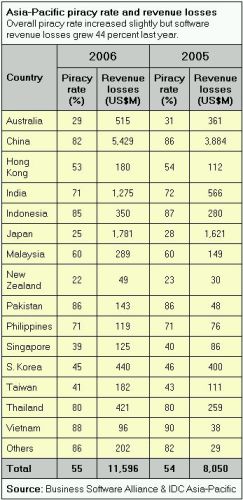Revenue loss from piracy in Asia up

Despite a dip in the overall software piracy rate, increased PC ownership and growing broadband Internet access have pushed up revenue losses due to piracy in Asia.
According to the latest software piracy report released Tuesday by the Business Software Alliance (BSA), the average piracy rate in the Asia-Pacific region, including Australia and Japan, grew slightly to 55 percent in 2006, compared to 54 percent in 2005. However, estimated revenue losses due to piracy rose sharply by 44 percent to US$11.6 billion last year, compared to US$8.1 billion the year before.
Conducted by research house IDC, the annual study tracks piracy of all packaged software running on personal computers including laptops, ultra-portables and desktops, and covers various software including operating systems, databases, security packages and PC games.
Walter Lee, vice president of consulting, IDC Asia-Pacific, explained that the sheer size of the PC market and growing software and Internet usage in emerging countries such as India and China, were the primary factors driving up revenue losses due to software piracy. Lee added that 42 million PCs were shipped in China, India, Brazil and Russia, alone last year.
In addition, noted Jeffrey Hardee, BSA's Asia vice president and regional director, 50 million households worldwide had broadband access last year, 25 million of those were in countries that had high piracy rates including Armenia, Vietnam and Indonesia. Hardee added that over 60 percent of Internet traffic today is driven by peer-to-peer (P2P) downloading.
| [? $GLOBALS[POLL_ID] = 20004964; template("/zd/common/poll/index.htm");?] |
According to the BSA-IDC study, estimated revenue losses from software piracy in China increased 39.8 percent from US$3.9 billion in 2005 to US$5.4 billion last year, while India saw its losses spike a staggering 125.3 percent to US$1.3 billion during the same period.
However, the average piracy rate in both countries fell over the past year. China saw a dip from 86 percent in 2005 to 82 percent last year, while India recorded a marginal reduction from 72 percent to 71 percent.
Asked if software prices had gone up, which in turn could have pushed up overall revenue losses, Lee noted that it was difficult to draw a direct correlation here since software vendors also offer a combination of software applications in a single package.
"Some vendors increase the price [of their software packages] by introducing a mix of different software [rather than just one]," he said.
 |
Hardee added that the region's falling piracy rate is encouraging. In fact, China's legitimate software market grew 88 percent to some US$1.2 billion in 2006, and at an average 358 percent growth since 2003. The country's piracy rate saw a 10 percent dive over the last three years from 92 percent in 2003 to its current 82 percent.
IDC's Lee attributed the declining piracy rates across several countries to better enforcement and increased efforts by governments, higher public awareness and education of intellectual property (IP) laws, as well as an increase in OEM (original equipment manufacturer) agreements between software makers and PC makers.
Hardee said: "Governments in the Asia-Pacific region have recognized the contributions and vast potential of the IT sector as an economic driver, and the corresponding importance of reducing software piracy."
However, the Asia-Pacific region now leads the global community with the highest revenue losses (US$11.6 billion) due to software piracy last year. The European Union, at US$11 billion, saw the second highest revenue losses as a result of software piracy, followed by Western Europe (US$10.6 billion) and North America (US$8.1 billion).
Worldwide, the average software piracy rate remained flat at 35 percent.